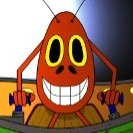-
Posts
672 -
Joined
-
Last visited
Everything posted by AffinityJules
-
Like most things in photo editing there are many ways to achieve the same result. Method 2 1. Open colour image. 2. Add a HSL Adjustment layer and desaturate the image. 3. With a black brush paint over the train to expose the original coloured image of the train. Adjustment layers come with built-in masks which behave in exactly the same way. This method is probably the easiest way to do it, but bear in mind that you will no longer have individual layers to make fine adjustments on.
-
Ok. This is really simple to do and doesn't take very long. Forget red leaves and such - you already have the burnt orange colour you want in the colour photograph; this will simplify matters. 1. You will need one colour image and one B&W image as separate files but of the same size. 2. Open the colour image then drag & drop the B&W image so that it's the top layer. 3. Add a mask to the B&W image. 4. With a brush set to black (colour), and mask selected, paint over the parts of the train you need to be orange; in effect this will erase the B&W parts and expose the orange image underneath. 5. To clean up the blue sky in the train window set the brush to white (mask selected) and carefully paint it out. 6. Because there are two separate layers you can now make colour/exposure/brightness and contrast, or any other adjustments you like before the image is flattened, or, make adjustments after the image is flattened. The choice is yours.
-
Many ways in which to do this type of thing and, the level of what looks like perlin noise helps out a bit. 1. I used the pen tool to outline the area around the heads and backrest of the cart. 2 Made the selection/feather 2/Inverted the selection. 3. New layer set to current layer and below. 4. Cloned out the offending areas in question. 5. Flattened document. Note: I never used the inpainting tool at all with this image because there was no call for it.
-
In my own observations when working with layers: if I skew or distort an image, I always have to rasterise it again in order to make it behave as expected with brushes. etc. I don't know if this behaviour is expected, or if it's a on-going bug? When using this software, I have found that, whenever I alter the dimensions of an image - be it size/skew or whatever, the outer edge of the image becomes pixelated until it is rasterised. I have no explanation for this but have observed this behaviour for some time. Like carl123 your image/layer behaved as normal after I rasterised it.
- 9 replies
-
- paint brush tool
- affinity photo
-
(and 3 more)
Tagged with:
-
There once existed a range of spray brushes which were integral to the Affinity Photo Suite. However, since the last update and even further back, these spray brushes have suddenly gone. I used to use the spray '8' brush (now completely missing) constantly in some of my work and I find that the spray category is no longer included in the brush list but has now merged with spray and splatter brushes. What has happened to these original spray brushes and is there any way that I can get them back? The supplied link is an old conversation I had with someone using the same set of brushes. This is for real reference in support that at one time they really did exist. https://forum.affinity.serif.com/index.php?/topic/84064-timelapse-of-making-artwork/&tab=comments#comment-443392









.thumb.jpg.e673d9f678891b69192e25ce1f6c8865.jpg)

